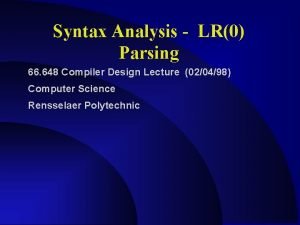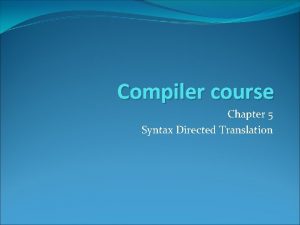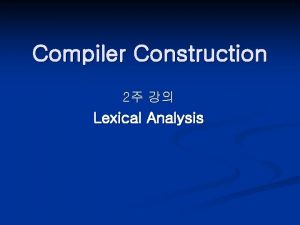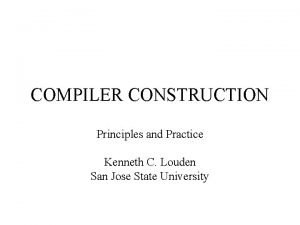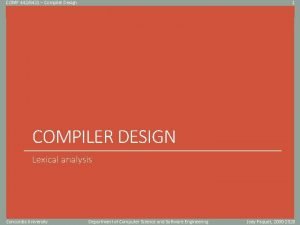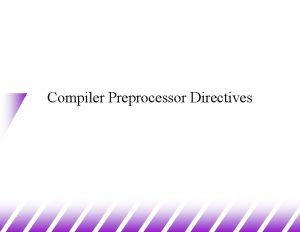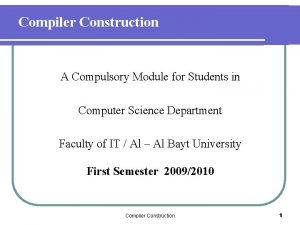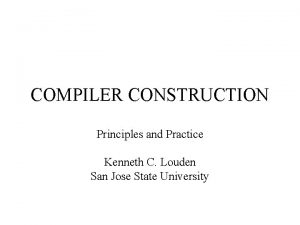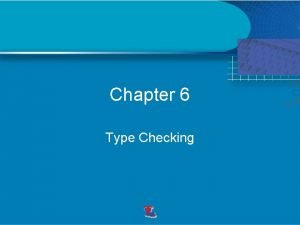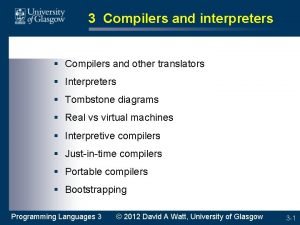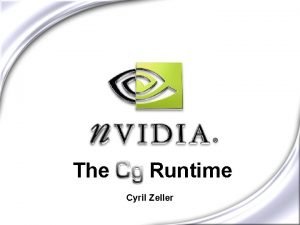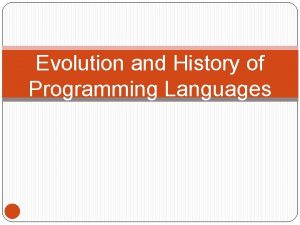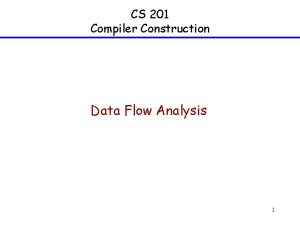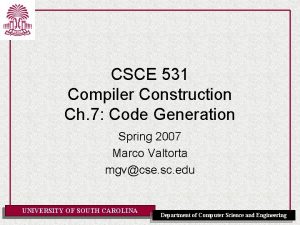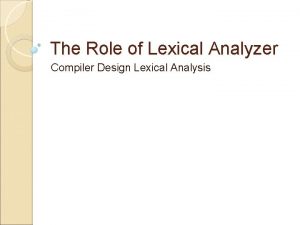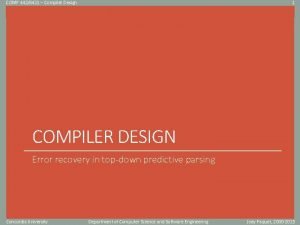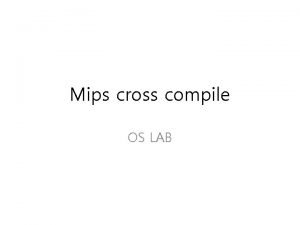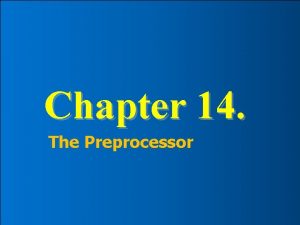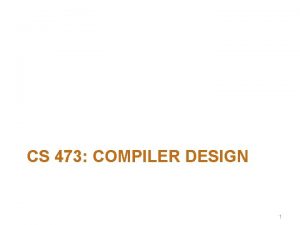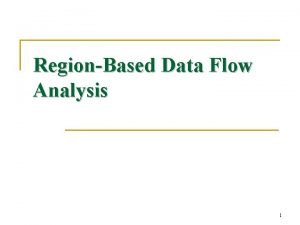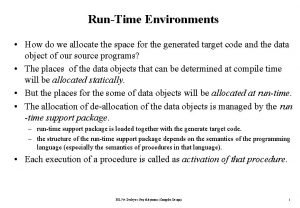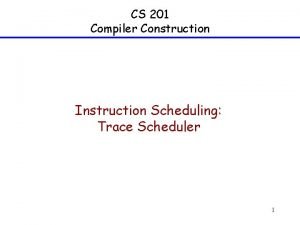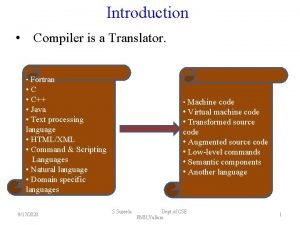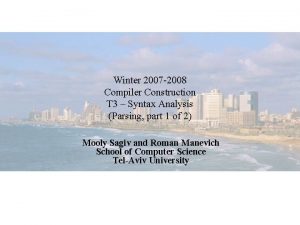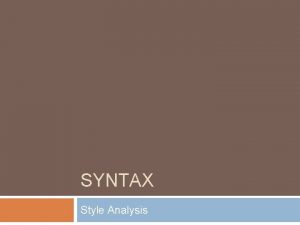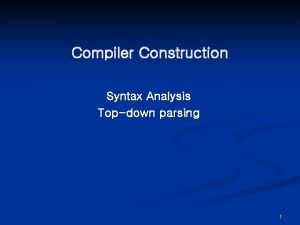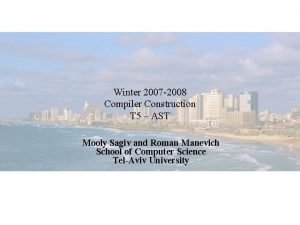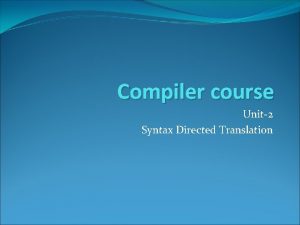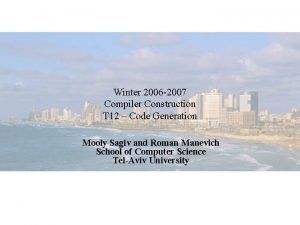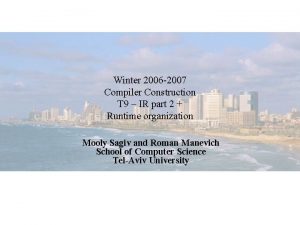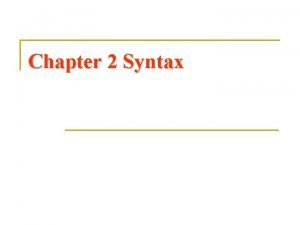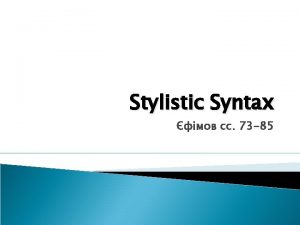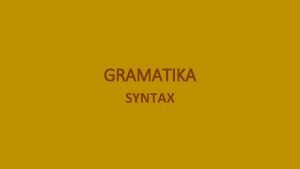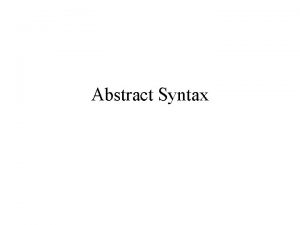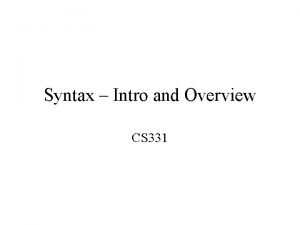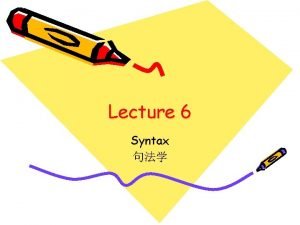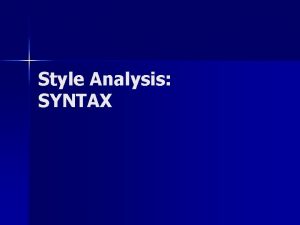Winter 2007 2008 Compiler Construction T 4 Syntax



































- Slides: 35

Winter 2007 -2008 Compiler Construction T 4 – Syntax Analysis (Parsing, part 2 of 2) Mooly Sagiv and Roman Manevich School of Computer Science Tel-Aviv University

Today ic IC Lexical Analysis Syntax Analysis Parsing AST Symbol Table etc. Language n Inter. Rep. (IR) Code Generation exe Executable code Today: n n n LR(0) parsing algorithms Java. Cup AST intro PA 2 Missing: error recovery 3

High-level structure text Lexer spec JFlex . javac Lexical analyzer IC/Parser/Lexer. java IC. lex tokens (Token. java) Parser spec IC. cup Library. cup Java. Cup . javac Parser IC/Parser/sym. java Parser. java Library. Parser. java AST 4

Expression calculator expr + expr | expr - expr | expr * expr | expr / expr | - expr | ( expr ) | number Goals of expression calculator parser: • Is 2+3+4+5 a valid expression? • What is the meaning (value) of this expression? 5

Syntax analysis with Java. Cup n n Java. Cup – parser generator Generates an LALR(1) Parser Input: spec file Output: a syntax analyzer tokens Parser spec Java. Cup . javac Parser AST 6

Java. Cup spec file n n n Package and import specifications User code components Symbol (terminal and non-terminal) lists n Terminals go to sym. java n Types of AST nodes Precedence declarations The grammar n Semantic actions to construct AST 7

Expression Calculator – 1 st Attempt terminal Integer NUMBER; terminal PLUS, MINUS, MULT, DIV; terminal LPAREN, RPAREN; Symbol type explained later non terminal Integer expr; expr : : = expr PLUS expr | expr MINUS expr | expr MULT expr | expr DIV expr | MINUS expr | LPAREN expr RPAREN | NUMBER ; 8

Ambiguities * + + a b * a c b c a*b+c + + + a b + a c a+b+c b c 9

Expression Calculator – 2 nd Attempt terminal Integer NUMBER; terminal PLUS, MINUS, MULT, DIV; terminal LPAREN, RPAREN; terminal UMINUS; non terminal Integer expr; precedence left PLUS, MINUS; precedence left DIV, MULT; precedence left UMINUS; expr : : = | | | ; expr PLUS expr MINUS expr MULT expr DIV expr MINUS expr %prec UMINUS LPAREN expr RPAREN NUMBER Increasing precedence Contextual precedence 10

Parsing ambiguous grammars using precedence declarations n Each terminal assigned with precedence n n n By default all terminals have lowest precedence User can assign his own precedence CUP assigns each production a precedence n n On shift/reduce conflict resolve ambiguity by comparing precedence of terminal and production and decides whether to shift or reduce In case of equal precedences left/right help resolve conflicts n n n Precedence of last terminal in production or user-specified contextual precedence left means reduce right means shift More information on precedence declarations in CUP’s manual 11

Resolving ambiguity precedence left PLUS + + + a b + a c b c a+b+c 12

Resolving ambiguity precedence left PLUS precedence left MULT * + + a b * a c b c a*b+c 13

Resolving ambiguity MINUS expr %prec UMINUS - b a a b -a-b 14

Resolving ambiguity terminal Integer NUMBER; PLUS, MINUS, MULT, DIV; LPAREN, RPAREN; UMINUS; UMINUS never returned by scanner (used only to define precedence) precedence left PLUS, MINUS; precedence left DIV, MULT; precedence left UMINUS; expr : : = | | | ; expr PLUS expr MINUS expr MULT expr DIV expr MINUS expr %prec UMINUS LPAREN expr RPAREN NUMBER Rule has precedence of UMINUS 15

More CUP directives n precedence nonassoc NEQ n n n start non-terminal n n n Non-associative operators: < > == != etc. 1<2<3 identified as an error (semantic error? ) Specifies start non-terminal other than first non-terminal Can change to test parts of grammar Getting internal representation n Command line options: n n -dump_grammar -dump_states -dump_tables -dump 16

CUP API n Link on the course web page to API n n Parser extends java_cup. runtime. lr_parser Various methods to report syntax errors, e. g. , override syntax_error(Symbol cur_token) 17

Scanner integration import java_cup. runtime. *; %% %cup Generated from token %eofval{ declarations in. cup file return new Symbol(sym. EOF); %eofval} NUMBER=[0 -9]+ %% <YYINITIAL>”+” { return new Symbol(sym. PLUS); } <YYINITIAL>”-” { return new Symbol(sym. MINUS); } <YYINITIAL>”*” { return new Symbol(sym. MULT); } <YYINITIAL>”/” { return new Symbol(sym. DIV); } <YYINITIAL>”(” { return new Symbol(sym. LPAREN); } <YYINITIAL>”)” { return new Symbol(sym. RPAREN); } <YYINITIAL>{NUMBER} { return new Symbol(sym. NUMBER, new Integer(yytext())); } <YYINITIAL>n { } <YYINITIAL>. { } Parser gets terminals from the scanner 18

Recap n n Package and import specifications and user code components Symbol (terminal and non-terminal) lists n n Precedence declarations n n Define building-blocks of the grammar May help resolve conflicts The grammar n May introduce conflicts that have to be resolved 19

Assigning meaning expr : : = expr PLUS expr | expr MINUS expr | expr MULT expr | expr DIV expr | MINUS expr %prec UMINUS | LPAREN expr RPAREN | NUMBER ; n n So far, only validation Add Java code implementing semantic actions 20

Assigning meaning expr : : = expr: e 1 PLUS expr: e 2 {: RESULT = new Integer(e 1. int. Value() + e 2. int. Value()); : } | expr: e 1 MINUS expr: e 2 {: RESULT = new Integer(e 1. int. Value() - e 2. int. Value()); : } | expr: e 1 MULT expr: e 2 {: RESULT = new Integer(e 1. int. Value() * e 2. int. Value()); : } | expr: e 1 DIV expr: e 2 {: RESULT = new Integer(e 1. int. Value() / e 2. int. Value()); : } | MINUS expr: e 1 {: RESULT = new Integer(0 - e 1. int. Value(); : } %prec UMINUS | LPAREN expr: e 1 RPAREN {: RESULT = e 1; : } | NUMBER: n {: RESULT = n; : } ; n n Symbol labels used to name variables RESULT names the left-hand side symbol 21

Building an AST n More useful representation of syntax tree n n Less clutter Actual level of detail depends on your design Basis for semantic analysis Later annotated with various information n n Type information Computed values 22

Parse tree vs. AST expr + expr 1 expr + ( 2 expr ) + ( 3 ) 1 2 3 23

AST construction n AST Nodes constructed during parsing n n Bottom-up parser n n Stored in push-down stack Grammar rules annotated with actions for AST construction When node is constructed all children available (already constructed) Node (RESULT) pushed on stack Top-down parser n More complicated 24

AST construction expr : : = expr: e 1 PLUS expr: e 2 {: RESULT = new plus(e 1, e 2); : } | LPAREN expr: e RPAREN {: RESULT = e; : } | INT_CONST: i {: RESULT = new int_const(…, i); : } 1 + (2) + (3) expr + (expr) plus e 1 e 2 expr 1 expr + ( 2 expr ) + ( 3 ) int_const val = 1 val = 2 val = 3 25

Designing an AST terminal Integer NUMBER; terminal PLUS, MINUS, MULT, DIV, LPAREN, RPAREN, SEMI; terminal UMINUS; non terminal Integer expr; non terminal expr_list, expr_part; precedence left PLUS, MINUS; precedence left DIV, MULT; precedence left UMINUS; expr_list : : = expr_list expr_part | expr_part ; expr_part : : = expr: e {: System. out. println("= " + e); : } SEMI ; expr : : = expr PLUS expr | expr MINUS expr | expr MULT expr | expr DIV expr | MINUS expr %prec UMINUS | LPAREN expr RPAREN | NUMBER ; 26

Designing an AST n Rules of thumb n n n Interfaces or abstract classes for non-terminals with alternatives Class for each non-terminal or group of related non-terminals with similar functionality Remember - bottom-up n n When constructing a node children nodes already constructed but parent not constructed yet 27

Designing an AST expr_list : : = expr_list expr_part | expr_part ; expr_part : : = expr SEMI ; expr : : = | | | ; Expr. Program Expr Alternative 2 Alternative 1: class for each op: Plus. Expr op type field of Expr Minus. Expr expr PLUS expr MINUS expr MULT expr DIV expr MINUS expr %prec UMINUS LPAREN expr RPAREN NUMBER Mult. Expr Div. Expr Unary. Minus. Expr Value. Expr 28

Designing an AST terminal Integer NUMBER; non terminal Expr expr, expr_part; non terminal Expr. Program expr_list; expr_list : : = expr_list: el expr_part: ep {: RESULT = el. add. Expression. Part(ep); : } | expr_part: ep {: RESULT = new Expr. Program(ep); : } ; expr_part : : = expr: e SEMI {: RESULT = e; : } ; expr : : = expr: e 1 PLUS expr: e 2 {: RESULT = new Expr(e 1, e 2, ”PLUS”); : } | expr: e 1 MINUS expr: e 2 {: RESULT = new Expr(e 1, e 2, ”MINUS”); : } | expr: e 1 MULT expr: e 2 {: RESULT = new Expr(e 1, e 2, ”MULT”); : } | expr: e 1 DIV expr: e 2 {: RESULT = new Expr(e 1, e 2, ”DIV”); : } | MINUS expr: e 1 {: RESULT = new Expr(e 1, ”UMINUS”); : } %prec UNMINUS | LPAREN expr RPAREN {: RESULT = e 1; : } | NUMBER: n {: RESULT = new Expr(n); : } ; 29

Designing an AST public abstract class ASTNode { // common AST nodes functionality } public class Expr extends ASTNode { private int value; private Expr left; private Expr right; private String operator; public Expr(Integer val) { value = val. int. Value(); } public Expr(Expr operand, String op) { this. left = operand; this. operator = op; } public Expr(Expr left, Expr right, String op) { this. left = left; this. right = right; this. operator = op; } } 30

Computing meaning n n Evaluate expression by AST traversal Traversal for debug printing Later – annotate AST More on AST next recitation 31

PA 2 n Write parser for IC Write parser for libic. sig n Check syntax n n n Emit either “Parsed [file] successfully!” or “Syntax error in [file]: [details]” -print-ast option n Prints one AST node per line 32

PA 2 – step 1 n Understand IC grammar in the manual n n Don’t touch the keyboard before understanding spec Write a debug Java. Cup spec for IC grammar n A spec with “debug actions” : print-out debug messages to understand what’s going on n Try “debug grammar” on a number of test cases Keep a copy of “debug grammar” spec around n Optional: perform error recovery n n Use Java. Cup error token 33

PA 2 – step 2 n Design AST class hierarchy Flesh out AST class hierarchy n n n Web-site contains an AST adapted with permission from Tovi Almozlino n n Don’t touch the keyboard before you understand the hierarchy Keep in mind that this is the basis for later stages (Code requires password which I will email to you) Change CUP actions to construct AST nodes 34

Partial example of main import java. io. *; IC. Lexer; IC. Parser. *; IC. AST. *; public class Compiler { public static void main(String[] args) { try { File. Reader txt. File = new File. Reader(args[0]); Lexer scanner = new Lexer(txt. File); Parser parser = new Parser(scanner); // parser. parse() returns Symbol, we use its value Prog. AST root = (Prog. AST) parser. parse(). value; System. out. println(“Parsed ” + args[0] + “ successfully!”); } catch (Syntax. Error e) { System. out. print(“Syntax error in ” + args[0] + “: “ + e); } if (library. File. Specified) {. . . try { File. Reader libic. File = new File. Reader(lib. Path); Lexer scanner = new Lexer(libic. File); Library. Parser parser = new Library. Parser(scanner); Class. AST root = (Class. AST) parser. parse(). value; System. out. println(“parsed “ + lib. Path + “ successfully!”); } catch (Syntax. Error e) { System. out. print(“Syntax error in “ + lib. Path + “ “ + e); } }. . . 35

See you next week 36
 Lex yacc example
Lex yacc example Cross compiler in compiler design
Cross compiler in compiler design 2008 2008
2008 2008 Syntax analysis in compiler design
Syntax analysis in compiler design Syntax directed definition in compiler design
Syntax directed definition in compiler design Syntax directed translation scheme
Syntax directed translation scheme Winter kommt winter kommt flocken fallen nieder
Winter kommt winter kommt flocken fallen nieder Es ist kalt es ist kalt flocken fallen nieder
Es ist kalt es ist kalt flocken fallen nieder Es war eine mutter
Es war eine mutter Front end of a compiler
Front end of a compiler Lexical analysis
Lexical analysis Compiler construction: principles and practice
Compiler construction: principles and practice Compiler frontend vs backend
Compiler frontend vs backend Thompson construction in compiler design
Thompson construction in compiler design Type checking in compiler construction
Type checking in compiler construction If an error occurs, what interpreter do?
If an error occurs, what interpreter do? Preprocessor in compiler construction
Preprocessor in compiler construction Machine independent code optimization
Machine independent code optimization Compiler construction: principles and practice
Compiler construction: principles and practice Type checking in compiler design
Type checking in compiler design Jdk provides an interpretive compiler for java.
Jdk provides an interpretive compiler for java. Loadcg.com
Loadcg.com Low level language
Low level language Very busy
Very busy Compiler code generation
Compiler code generation Lexeme in compiler design
Lexeme in compiler design Compiler
Compiler Mips
Mips Compiler control directives in c
Compiler control directives in c Induction variable elimination in compiler design
Induction variable elimination in compiler design Available expression in compiler design
Available expression in compiler design Compiler
Compiler Region based analysis in compiler
Region based analysis in compiler Activation tree in compiler design
Activation tree in compiler design Trace scheduling
Trace scheduling Cse pmu
Cse pmu



